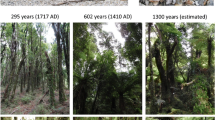Abstract
From 1984 to 1986, old-field succession on sterilized sand and loam was studied under different water- and nutrient regimes. Within one month, moss and phanerogam species appeared on all experimental plots but further succession was rather varied. Salix species established quickly on loam and formed within 3 years a shrub layer up to 3 m in height. On sand, woody plant species were observed only at a high ground-water level. On loam, the well-known old-field succession from short-living therophytes to long-living phanerophytes of clearings and woodlands proceeded very quickly. In contrast, on sand, therophytes, hemicryptophytes and herbaceous chamaephytes of ruderal- and grassland communities were still dominant after three years. A high ground-water level as well as mineral fertilization had sometimes positive, sometimes negative effects on this succession. Periodic estimates of cover, made during the succession were supplemented at the end of the experiment by the measurements of phytomass and bioelement storage. The highest amount of biomass was measured on the three loamy soils where shrub layers were well developed. In comparison with data published elsewhere, the above-ground biomass of 2.2–2.8 kg dry matter m-2 and the below-ground biomass up to 7.2 kg dry matter m-2 were both extraordinarily high. Over the three years, the vegetation on sandy soils accumulated between 1.2 and 5.1 g N m-2 yr-1 and on loamy soils between 17.1 and 24.7 g N m-2 yr-1.
Similar content being viewed by others
References
Armesto J. J. & Pickett S. T. A. 1986. Removal experiments to test mechanisms of plant succession in oldfields. Vegetatio 66: 85–93.
Bornkamm R. 1984. Experimentell-ökologische Untersuchungen zur Sukzession von ruderalen Pflanzengesellschaften. II. Quantität und Qualität der Phytomasse. Flora 175: 45–74.
Bornkamm R. & Henning U. 1982. Experimentell-ökologische Untersuchungen zur Sukzession von ruderalen Pflanzengesellschaften auf unterschiedlichen Böden. Flora 172: 267–316.
Braun-Blanquet J. 1964. Pflanzensoziologie, 3rd ed. Springer, Wien, New York.
Büring, H. 1970. Sozialbrache auf Äckern und Wiesen in pflanzensoziologischer und ökologischer Sicht. Thesis Univ. Gießen.
Ellenberg, H. 1979. Zeigerwerte der Gefäßpflanzen Mitteleuropas. Scripta Geobot. 9.
Ellenberg H. 1986. Vegetation Mitteleuropas mit den Alpen. 4th ed. Ulmer, Stuttgart.
Ernst W. 1978. Discrepancy between ecological and physiological optima of plant species. A re-interpretation. Oecol. Plant. 13: 175–188.
Hahn W., Wolf A. & Schmidt W. 1979. Untersuchungen zum Stickstoff-Umsatz von Tussilago farfara und Agropyron repens-Beständen. Verhandl. Ges. Ökol. 7: 369–380.
Hard G. 1972. Wald gegen Driesch. Das Vorrücken des Waldes auf Flächen junger ‘Sozialbrache’. Ber. Dtsch. Landesk. 46: 49–80.
Harper J. L. 1977. Population biology of plants. Academic Press, London, New York, San Francisco.
Parrish J. A. D. & Bazzaz F. A. 1976. Underground niche separation in successional plants. Ecology 57: 1281–1288.
Parrish J. A. D. & Bazzaz F. A. 1979. Difference in pollination niche relationships in early and late successional plant communities. Ecology 60: 597–610.
Parrish J. A. D. & Bazzaz F. A. 1982a. Competitive interactions in plant communities of different successional ages. Ecology 63: 314–320.
Parrish J. A. D. & Bazzaz F. A. 1982b. Responses of plants from three successional communities to a nutrient gradient. J. Ecol. 70: 233–248.
Pickett S. T. A. 1982. Population patterns through twenty years of oldfield succession. Vegetatio 49: 45–59.
Pickett S. T. A. & Bazzaz F. A. 1976. Divergence of two cooccurring successional annuals on a soil moisture gradient. Ecology 57: 169–176.
Pickett S. T. A. & Bazzaz F. A. 1978. Organisation of an assemblage of early successional species on a soil moisture gradient. Ecology 59: 1248–1255.
Sachs L. 1978. Angewandte Statistik. 5th ed. Springer, Berlin, Heidelberg, New York.
Schiefer J. 1981. Bracheversuche in Baden-Württemberg-Vegetations- und Standortsentwicklung auf 16 verschiedenen Versuchsflächen mit unterschiedlichen Behandlungen (Beweidung, Mulchen, kontrolliertes Brennen, ungestörte Sukzession). Veröff. Naturschutz Landschaftspfl. Baden-Würtemberg Beih. 22: 1–325.
Schmidt, W. 1981a. Ungestörte und gelenkte Sukzession auf Brachäckern. Scripta Geobot. 15.
Schmidt W. 1981b. Über das Konkurrenzverhalten von Solidago canadensis und Urtica dioica. Verhandl. Ges. Ökol. 9: 173–188.
Schmidt W. 1983a. Experimentelle Syndynamik — Neuere Wege zu einer exakten Sukzessionsforschung, dargestellt am Beispiel der Gehölzentwicklung auf Ackerbrachen. Ber. Dtsch. Bot. Ges. 96: 511–533.
Schmidt W. 1983b. Über das Konkurrenzverhalten von Solidago canadensis und Urtica dioica. II. Biomasse und Streu. Verhandl. Ges. Ökol. 11: 373–384.
Schmidt W. 1985. Mahd ohne Düngung-Vegetationskundliche und ökologische Ergebnisse aus Dauerflächenuntersuchungen zur Pflege von Brachflächen. Münstersche Geogr. Arb. 20: 81–99.
Schmidt W. 1986a. Über die Dynamik der Vegetation auf bodenbearbeiteten Flächen. Tuexenia 6: 53–74.
Schmidt W. 1986b. Über das Konkurrenzverhalten von Solidago canadensis und Urtica dioica. III. Stickstoff- und Phosphorhaushalt. Verhandl. Ges. Ökol. 14: 537–550.
Schreiber K.-F. & Schiefer J. 1985. Vegetations- und Stoffdynamik in Gründlandbrachen-10 Jahre Bracheversuche in Baden-Württemberg. Münstersche Geogr. Arb. 20: 111–153.
Stüssi, B. 1970. Naturbedingte Entwicklung subalpiner Weiderasen auf Alp La Schera im Schweizer Nationalpark während der Reservatsperiode 1939–1965. Ergeb. Wiss. Unters. Schweiz. Nationalpark 13.
von Borstel, U. O. 1974. Untersuchungen zur Vegetationsentwicklung auf ökologische verschiedenen Gründland- und Ackerbrachen hessischer Mittelgebirge (Westerwald, Rhön, Vogelsberg). Thesis Univ. Gießen.
Werner, W. 1983. Untersuchungen zum Stickstoffhaushalt einiger Pflanzenbestände. Scripta Geobot. 16.
Wittig R. 1978. Zur pflanzensoziologischen und ökologischen Stellung ruderaler Bestände von Solidago canadensis und Solidago gigantea.AIT. (Asteraceae) innerhalb der Klasse Artemisietea. Decheniana 131: 33–38.
Author information
Authors and Affiliations
Rights and permissions
About this article
Cite this article
Schmidt, W. An experimental study of old-field succession in relation to different environmental factors. Vegetatio 77, 103–114 (1988). https://doi.org/10.1007/BF00045756
Accepted:
Issue Date:
DOI: https://doi.org/10.1007/BF00045756




